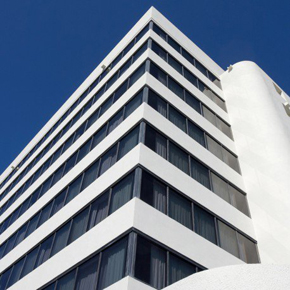
Last minute projects before the new year: masonry paints
Although not necessarily ideal, painting in these colder months should not stop your project dead in its tracks. As we are entering the colder months of the year, it is important to realise that unpredictable weather will always impact delivery schedules and project deadlines.
Professionals will already be more than aware that painting in spring and summer is significantly more straight forward than painting in autumn, or even winter. Nevertheless, masonry painting is not completely out of the question with the right precautions and materials. The colder weather no longer has to completely rule out renovation and masonry work. Let’s review.
Cold weather painting
It is vital to understand how paint responds and reacts in colder weather. Humidity levels, temperature and expected precipitation will all impact the expected curing and drying time of paint. Not only that, cold temperatures will also impact the viscosity of the paint. Water-based and latex-based paints have the potential of freezing when the temperature drops too low. It can be detrimental to the quality of the paint to go through several freeze and thaw cycles. If your paint has become lumpy rather than having that smooth consistency paint usually has, then your paint has become unusable. By certain special additives, latex-based and water-based paints can become more resistant to freezing. Oil-based paints on the other hand are more resistant to freezing by nature due to its composition. However, the consistency of the paint will be affected and thinning paint that has become thicker will be required.
It’s not just temperature that affects your paint. Humidity levels are also vital and will affect both latex-based and oil-based paints. Read the technical data sheets that come with the paint, as the optimal relative humidity (RH) levels will differ based per masonry paint.
Drying & curing time
Lower temperatures will slow the overall drying time of the paint. Most drying times have been calculated around an ambient temperature of 20°C. Thus, when working with temperatures below 10°C the drying time will increase. The same principle applies to the curing time. If it usually takes a full 48 hours to achieve full hardness, then working with lower temperatures will affect when your coatings have completely cured.
Awareness of extended drying and curing time is important as this will then affect your recoating time. Overall, when planning a masonry paint job, these aspects will impact your overall time management and planning.
Potential issues & solutions
Painting conditions will hardly ever be perfect. Nevertheless, cold weather painting brings various risks along with it. You run the risk of colour uniformity issues, touch-up issues, reduced paint coverage due to viscosity changes or water spotting issues.
So what can you do to ensure the successful completion of exterior masonry jobs? Work with specialist exterior masonry paints to increase your changes of a successful completion of your paint job and eliminate those potential issues. There are many brands that stock paints designed for cold weather or all-weather applications, where paint can be applied in adverse weather conditions and with temperatures as low as minus 5°C.
Use a high quality bonding primer to ensure adhesion and avoid any adhesion issues. Make sure to use primers, paints and topcoats that have been designed to work together. Compatibility is important to avoid any additional issues later on with peeling or cracking paint.
Consider starting a little later in the day when the temperature has had time to go up a little due to additional sun exposure. This will also allow dew to evaporate and will give your substrate a time to warm up a little too. And always, always make sure you store your paint and materials in a protected environment. The last thing you need is ruined paint if it’s become too cold.
The cold weather might have set in and we’re collectively getting ready for Christmas, this won’t necessarily mean the end of your painting jobs. Cold-weather paints and products will extend the timeframe where you can except masonry painting jobs, creating additional potential for profit.
Author: Annick Meijboom
Latest news

21st February 2025
ASSA ABLOY EMEIA: Save valuable time and money with a seamless switch to programmable digital keys
In 2025, access management can be a whole lot easier. By making access part of their digital processes, businesses can put time-consuming key management and the cost of changing the locks firmly behind them. Making this switch is a lot easier than many people think, as ASSA ABLOY explains here…
Posted in Access Control & Door Entry Systems, Architectural Ironmongery, Articles, Building Industry News, Building Products & Structures, Building Services, Doors, Facility Management & Building Services, Health & Safety, Information Technology, Innovations & New Products, Retrofit & Renovation, Security and Fire Protection
21st February 2025
Showersave supports industry leaders in addressing Part L and Part G regulations
Showersave has sponsored and participated in a recent Building Insights LIVE roundtable on ‘Water & Energy Saving Innovations in New Build Housing’.
Posted in Articles, Bathrooms & Toilets, Bathrooms, Bedrooms & Washrooms, Building Associations & Institutes, Building Industry Events, Building Industry News, Building Products & Structures, Building Regulations & Accreditations, Building Services, Exhibitions and Conferences, Interiors, Pipes & Fittings, Plumbing, Retrofit & Renovation, Sustainability & Energy Efficiency
21st February 2025
GEZE: The importance of Specifying High Quality Door Closers on Fire Doors
Andy Howland, Sales & Marketing Director at GEZE UK, discusses why specifying high quality door closers on fire doors is important…
Posted in Access Control & Door Entry Systems, Accessibility, Architectural Ironmongery, Articles, Building Industry News, Building Products & Structures, Building Regulations & Accreditations, Building Services, Doors, Facility Management & Building Services, Health & Safety, Posts, Restoration & Refurbishment, Retrofit & Renovation, Security and Fire Protection
21st February 2025
Insight Data achieves ISO9001 recertification with zero non-conformities
Leading industry data specialist, Insight Data, has successfully achieved the prestigious recertification for ISO9001 with zero non-conformities for the fourth consecutive year.
Posted in Articles, Building Industry News, Building Regulations & Accreditations, Building Services, Information Technology, Research & Materials Testing
 Sign up:
Sign up: